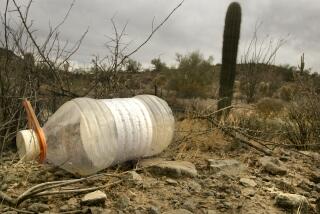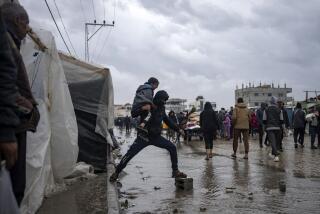Together, Cairo’s poor and poorer get heard
- Share via
CAIRO — The neighborhood was so poor it didn’t even have a proper name save for “4.5,” its distance in kilometers from the nearest major bus terminal.
When tensions between impoverished Egyptians and even more destitute Sudanese refugees reached a boiling point in March 2005, relief agencies and community leaders assembled an emergency workshop to keep fights from escalating.
They found the roots of 4.5’s quandaries lay neither in the behavior of its dark-skinned newcomers fleeing war, nor the attitudes of the Egyptians, many of them recent arrivals to the big city from the country’s rural south. The problem was the district: a decrepit, rapidly growing area lacking water, power or a police presence.
Clerics, relief workers, residents and refugees banded together and pressed the government for power lines, water mains, sewers, schools and clinics. A government that might otherwise have ignored the pleas bowed to pressure from aid groups and mosques. The tensions eased. Life improved.
“We are refugees,” said Amir Khaled, 27, a Sudanese native who has lived in the neighborhood since 2005, when he fled the bloodshed in Sudan’s Darfur region. “It’s not easy to ask the government for services.
“At first no one understood each other,” he said. “There were cultural differences. But there has been some kind of progress in the area. Now there is cooperation. Relations became better because the life here improved. We realized that we were both poor.”
At 20 million people, Cairo is Africa’s largest metropolis and has one of the biggest urban refugee populations in the world. Officially the number is 30,000, though unofficial estimates are as high as 500,000 asylum-seekers and refugees from 35 nations.
Most aid agencies praise Egypt for generally accepting refugees even though it faces staggering poverty and economic malaise. But in poor neighborhoods such as 4.5, tensions persist between refugees and locals, who accuse newcomers of everything from driving down wages to committing crime.
In 4.5, the name-calling, taunts and street fights had reached a fever pitch in 2005 when the local branch of the United Nations High Commission for Refugees convened the workshop. Officials told Egyptian mosque and community leaders that the refugees were there in accord with international law.
Many Egyptian residents of the neighborhood were uneducated recent arrivals to the city and “didn’t even understand why the Sudanese are here,” said Tawer Mirghali Ali, a Sudanese and former accountant who runs a school for refugee children and attended the workshop. “They didn’t even understand what a refugee is. They thought they were here only because they were poor and looking for some food to eat.”
The community leaders concluded that the rapid growth of the neighborhood, in a desert area on the city’s eastern edge, had made it particularly miserable. Throughout Cairo it had become infamous as a magnet for criminals, a haven for car thieves.
The Egyptians were suffering just as much as the Sudanese. They began pressing politicians for amenities. The Sudanese, some of them doctors and lawyers well- connected to the aid networks, provided the savvy the rural Egyptians lacked.
“The pressure came from both sides,” said Boutros Ahot Manat Deng, general manager of Serving the Refugees and the Community, a nonprofit. “It came from the Sudanese [organizations], and it came from the Egyptians, from their mosques and churches.”
Officials listened. Today, 4.5 remains poor but far from the desperate makeshift outpost it was, thanks to a rare instance of cooperation between the poor and even poorer.
“In Cairo’s shantytowns, survival itself is a triumph, one that demands a degree of participation,” said author Maria Golia, who wrote about 4.5 in her book “Cairo: City of Sand,” an examination of urban space and culture in the Egyptian capital. “While middle- and upper-class members may feel they can afford an every-man-for-itself detachment from their neighbors and communities, it’s not really an option for the poor.”
On a recent visit to 4.5, people hung ornaments for a wedding between precarious apartment buildings hanging over narrow unpaved streets. Children whistled and laughed as they chased ice cream vendors.
“The neighborhood has improved a lot,” said Fawzi Abu Ela, a 66-year-old mechanic who has lived in 4.5 for two decades.
“At the beginning we suffered a lot from the lack of water, sewage, electricity. A lack of trash collection created hygiene problems that made all the food very bad. But now everything is available, even phone lines.”
Ela even dug up an old name for the district, which he thinks should be adopted: Ezbet el-Hegeneh, or “Ranch of the Guardians.”
--
More to Read
Sign up for Essential California
The most important California stories and recommendations in your inbox every morning.
You may occasionally receive promotional content from the Los Angeles Times.










